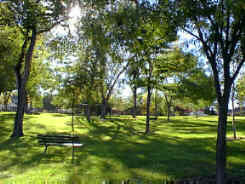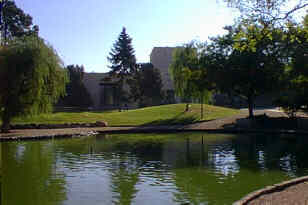Mumford facetiously suggested that perhaps one day Los Angeles would evict its remaining inhabitants and "turn the entire area over to automatically propelled vehicles, completely emancipated from any rational human purpose." Being a pedestrian in Albuquerque, or in any American car town these days, gives you the eerie feeling that the great eviction is already under way.
 |
One of the most common walking environments in a city such as ours is indeed the parking lot. We must spend at least a quarter of our walking lives snaking between parked cars and dodging parkers through those great asphalt wastes. Parking lots are not made for people, even with their trees and shrubs. And much of Albuquerque isn't made for people either. If Mumford is right, about a third of it is all that's left for us, and too much of that only begrudgingly accommodates the need for bipeds to walk.
If you ride the bus, you are no doubt familiar with the worst of Albuquerque's walking places - most of its city streets. The bus traveler who gets off at Lomas and San Mateo on the west side of the street knows how important the pedestrian is in the Duke City. San Mateo there, and for most of its length as well, is the essence of the car town's built environment - a harsh and lifeless accommodation of speed and machines where creatures of flesh and blood do not belong.
Providing pedestrian pathways accessible to persons with disabilities is an especially challenging problem that must be worked on. And although Albuquerque suffers from some grotesque walking environments, it does have its occasional joys. Favorite places to walk are filled with architectural pleasures - such as Gold Street downtown and the central campus of UNM.
Other enlivening parts for walkers include Old Town, Huning Highlands, Silver Hills on Silver south of Yale, the Country Club area, parts of Central downtown, Spruce Park (especially on Las Lomas from University to Oak), the downtown neighborhood on Eleventh and Twelfth south of Lomas, and the Rio Grande Zoo. There are others, of course, but they are rare.
Doing business on Gold downtown, between Fifth and Second, is a favorite urban walking experience in Albuquerque. Perhaps it is that so many shopkeepers and other people on that street project an urban warmth, a human scale that makes people feel good.
The pleasure derived from Gold has much to do, too, with the grand buildings on that street - from the 1908 Federal Building with its golden dome (the first real federal building in the city) and the magnificent Occident Life Insurance Building (the "Doge's Palace") to the Mission style Hubbell Agency Building at 312 Gold SW, the revived Pacific Desk Company, 213 Gold SW, and the renovated brick office building at 220 Gold SW.
But the lively character of Gold is being eroded. It has become a bus docking center, which has cut out much of its street parking. And the razing of a fine row of old office buildings seriously detracts from the pleasant quality this street has had in the past.
 |
One of the best urban walking environments in the city is the central campus of UNM. Experiencing it, however, depends on finding a place to park legally. But once you have, it becomes clear that UNM is a built environment designed specifically for walkers. It is an architectural and landscaping oasis of great and refreshing beauty, a truly modern New Mexico urban environment that both respects and evokes the history and culture of the region.
The Spanish Pueblo style of John Gaw Meems' buildings on campus form a temporary harmony with the modernist New Mexico vernacular building done in recent years. There is an intimacy to the built environment there, an attention to eye-level detail, and detail that can be seen while moving at pedestrian speeds - all of which makes a person feel welcome and important. The landscaping is for comfort, not for disguise. And never does the walker feel as if the environment suffers him grudgingly.
Like Gold Street, UNM's central campus is meant for people, not for automobiles. Pedestrians find it a relief to be in a built environment that makes them feel like real human beings, not merely drivers who have untidily left their cars.
*Condensed from "There's a Challenge Afoot for Walkers in Albuquerque," by V. B. Price, Albuquerque Journal.
(Up to Section II, Back to Architecture and Infrastructure, On to Urban Design)